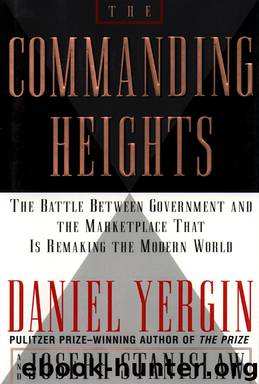The Commanding Heights by Daniel Yergin

Author:Daniel Yergin
Format: epub
Publisher: SIMON & SCHUSTER
Published: 1997-12-31T16:00:00+00:00
Dependencia Rules
The traditional statist approach in Latin America was greatly influenced by what was known as dependencia, or dependency theory. It rationalized state dominance—high import barriers, a closed economy, and a general demotion of the market. And from the end of the 1940s right up to the 1980s, dependencia ruled. Its origins were in the late 1920s and 1930s and the Great Depression, when the collapse of commodity prices devastated the export-oriented economies of Latin America. Meanwhile, in line with the tenor of those times, “national security” became a justification for governments to take over “strategic sectors” of the economy to meet the needs of the nation, not those of international investors. This led, notably, to the founding of state oil companies in a number of countries. After World War II, the shift toward a much greater reliance on the state was propelled by the emergence in the West of both the welfare state and Keynesian interventionism and by the prestige of Marxism and the Soviet Union. One other thing motivated both Latin American economists and their governments: anti-Americanism—fear of the colossus to the north, and antipathy to what were seen as exploitative American corporations operating in the Latin arena.
The dependencia theorists rejected the benefits of world trade. By the end of the 1940s, the essential elements of their thinking were already articulated and promoted by the United Nations Economic Commission on Latin America (ECLA)—and most notably by an Argentinean economist named Raúl Prebisch, who headed the commission from 1948 until 1962. He began his career, in his words, as “a firm believer in neoclassical theories.” But “the first great crisis of capitalism—the Great Depression—prompted in me serious doubts regarding those beliefs.” Prebisch and those who joined him at ECLA propounded an international version of the inevitability of class warfare. They argued that the world economy was divided into the industrial “center”—the United States and Western Europe—and the commodity-producing “periphery.” The terms of trade would always work against the periphery, meaning that the center would consistently exploit the periphery. The rich would get richer and the poor would get poorer. International trade, in this formulation, was not a method to raise standards of living but rather a form of exploitation and robbery, committed by the industrial nations and their multinational corporations. The victims were the peoples of the developing world. This belief became the received wisdom in universities across Latin America.
So instead, the periphery would go its own way. Rather than exporting commodities and importing finished goods, these countries would move as rapidly as possible toward what was called “import-substituting” industrialization (ISI). This would be achieved by breaking the links to world trade through high tariffs and other forms of protectionism. The infant-industry logic became the all-industry logic. Currencies were overvalued, which cheapened equipment imports needed for industrialization; all other imports were tightly rationed through permits and licenses. Overvalued currencies also discouraged agricultural and other commodity exports by raising their prices and thus making them uncompetitive. Domestic prices were controlled and manipulated, and subsidies were widespread.
Download
This site does not store any files on its server. We only index and link to content provided by other sites. Please contact the content providers to delete copyright contents if any and email us, we'll remove relevant links or contents immediately.
The Secret History by Donna Tartt(18945)
The Social Justice Warrior Handbook by Lisa De Pasquale(12165)
Thirteen Reasons Why by Jay Asher(8841)
This Is How You Lose Her by Junot Diaz(6833)
Weapons of Math Destruction by Cathy O'Neil(6214)
Zero to One by Peter Thiel(5731)
Beartown by Fredrik Backman(5673)
The Myth of the Strong Leader by Archie Brown(5456)
The Fire Next Time by James Baldwin(5380)
How Democracies Die by Steven Levitsky & Daniel Ziblatt(5170)
Promise Me, Dad by Joe Biden(5112)
Stone's Rules by Roger Stone(5051)
A Higher Loyalty: Truth, Lies, and Leadership by James Comey(4905)
100 Deadly Skills by Clint Emerson(4879)
Rise and Kill First by Ronen Bergman(4739)
Secrecy World by Jake Bernstein(4698)
The David Icke Guide to the Global Conspiracy (and how to end it) by David Icke(4655)
The Farm by Tom Rob Smith(4465)
The Doomsday Machine by Daniel Ellsberg(4449)
